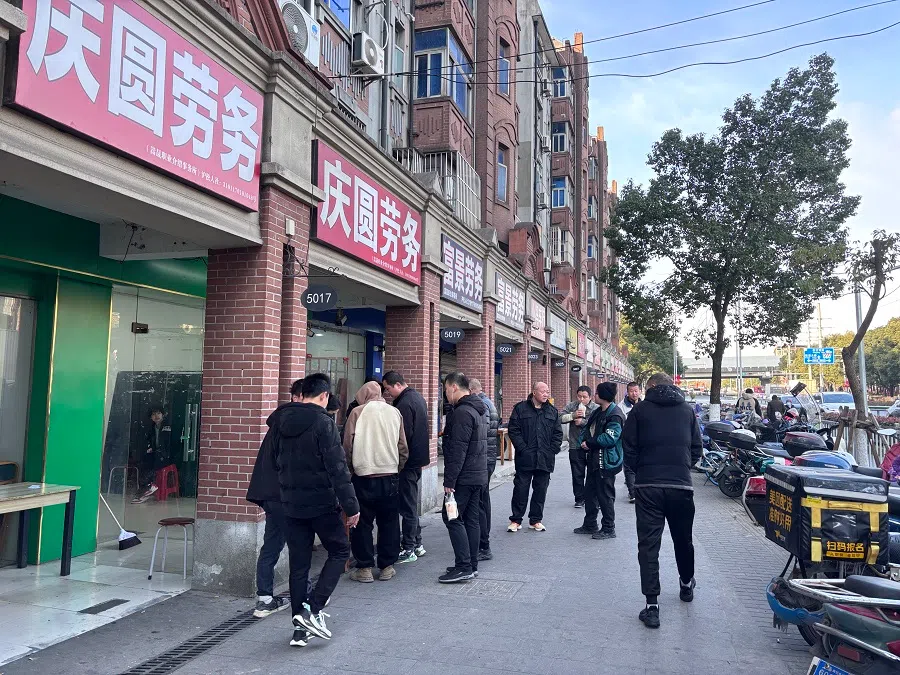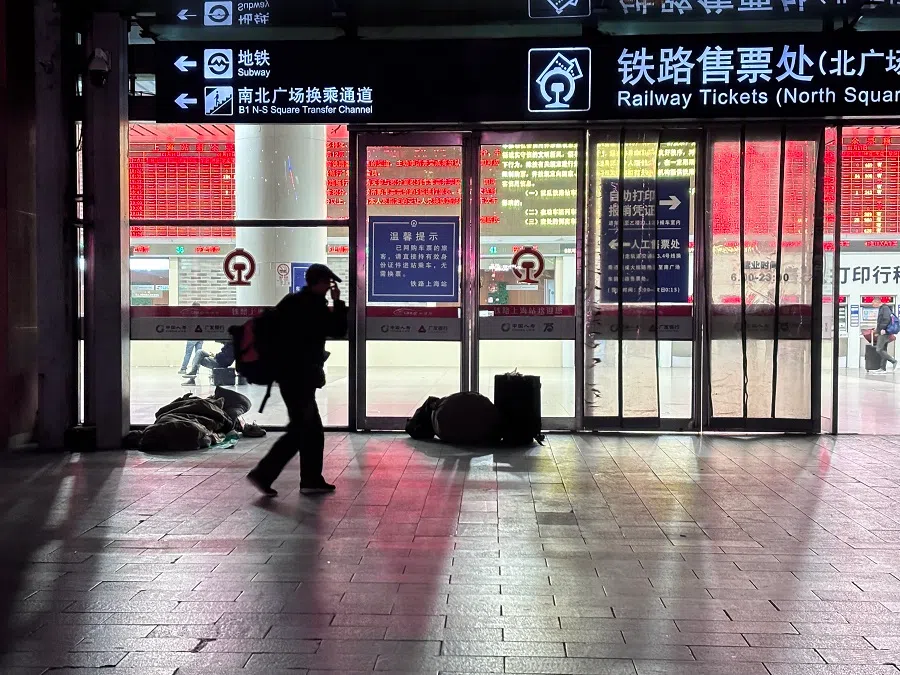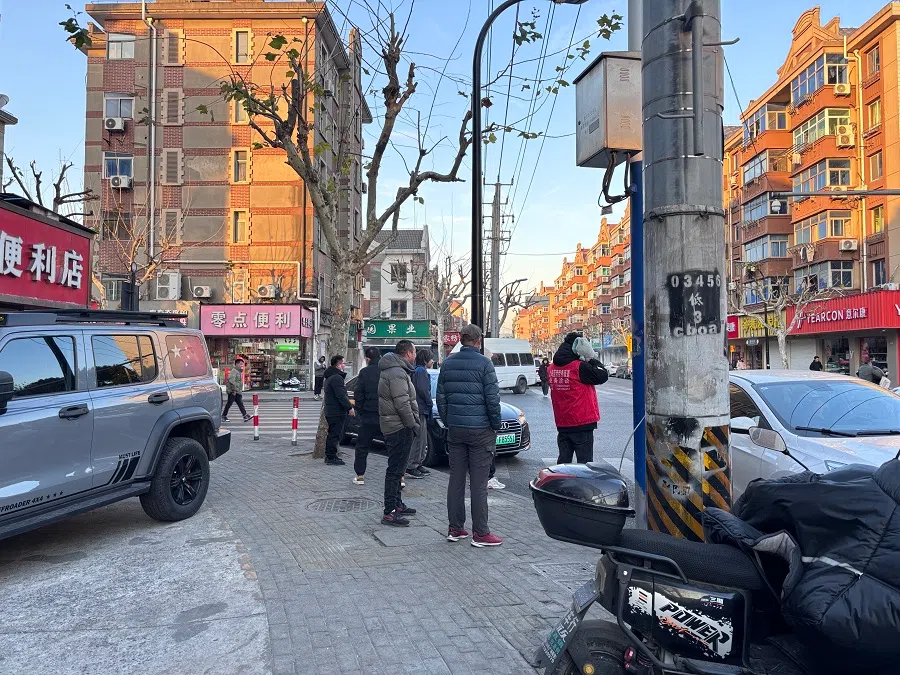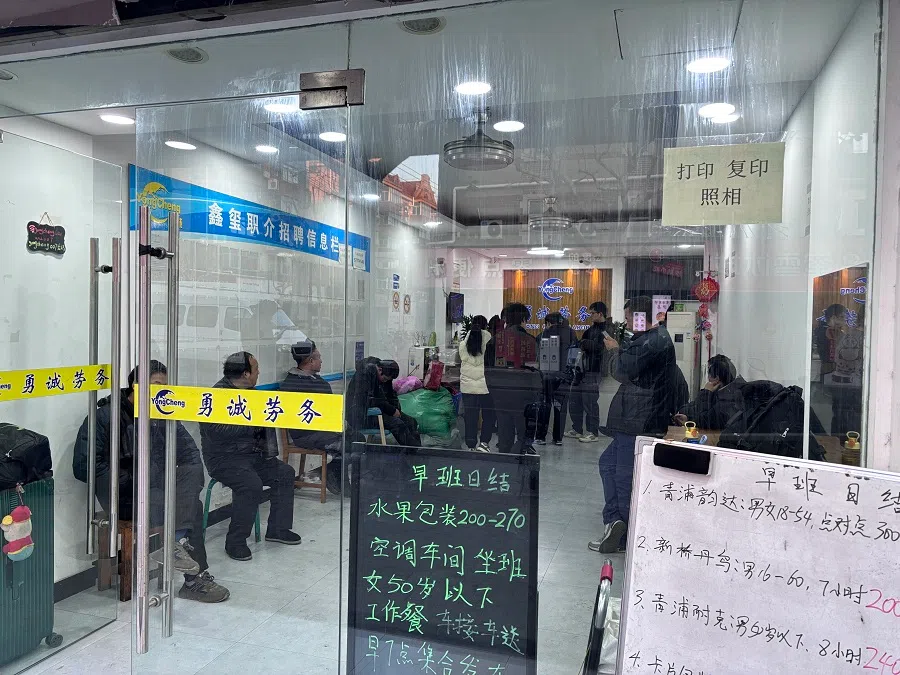[Big read] Young and underemployed: The new face of China’s gig economy

With intense competition for employment in China, more people are becoming daily wage workers, or gig workers. But while the gig economy offers more freedom in terms of time, jobs and salary are unstable. Lianhe Zaobao correspondent Li Kang speaks to gig workers and academics to find out more about what drives the industry.
At 5:24 am, 38-year-old Wang Yong (pseudonym) walks through the pitch-dark streets in a suburb of Shanghai in the minus 1 degree cold, and arrives at the door of a labour agency.
Without even asking about the wage or the type of work, and in a well-practised manner, Wang takes out his identity card and gives it to a labour agent holding a stack of documents. Here, handing over an ID card means securing a one-day labour contract.
‘Daily wage gods’
Today, Wang’s job is loading goods for logistics, at 24 RMB (US$3.29) per hour. With less than two weeks until the Chinese New Year, this was one of his few available options. Wang says softly: “Normally, the pay isn’t this high. It’s only because there are fewer workers before the New Year that I can earn a higher wage for a few days.”
In just a thin sweatshirt, Wang stomps his feet against the cold as he speaks with me. After finishing a cigarette, he hurries onto the bus. At 6 am sharp, the bus departs on time, carrying Wang and a full load of workers to the job site.
Wang, who has a junior high school education, told Lianhe Zaobao that he left home to work at the age of 18, working on construction sites and in factories before becoming a “daily wage god” in Shanghai in 2015, a routine he has followed for 10 years.
In China, this group of workers, who do not have fixed jobs and take on different gig jobs daily, are respectfully referred to by netizens as “daily wage gods” (日结大神). They adopt a casual approach to work — taking jobs when they want and resting when they do not — wandering around the outskirts of major cities, free to leave or stay as they please.
While “daily wage gods” is a new concept, the history of gig work in China dates back to the 1980s. After the reform and opening-up period, more than 100 million migrant workers flooded into cities, while those who could not secure jobs in factories or construction sites gradually entered the gig economy.
Only when new workers arrived did Liu [the labour agent on duty] announce the full details: “Pudong! Packing and logistics, 290 RMB per day, let’s go!”

To this day, neither official data nor social research provides a clear estimate of the number of daily wage workers, or gig workers. However, scholars interviewed by the media estimate that out of China’s 200 million flexible workers, excluding those in new job sectors and self-employed businesses, there are roughly 20 million gig workers.
In terms of distribution, large-scale daily wage labour markets have formed in the suburbs of China’s four top-tier cities: Majuqiao in Beijing, Songjiang in Shanghai, Shiling Town in Guangzhou, and the Sanhe Talent Market in Shenzhen. Similar markets have emerged in the provincial capital cities of labour-rich provinces like Henan and Anhui.
Chedun town: Shanghai’s daily-rated manpower market
Shanghai’s daily wage labour market is located in Chedun town, Songjiang district, about 40 kilometres southwest of downtown Shanghai. Compared to the towering skyscrapers of the city centre, this area resembles a small county town.
However, as one of Shanghai’s major industrial hubs, Chedun is home to more than 1,200 manufacturing enterprises, creating numerous job opportunities and attracting large numbers of migrant workers. According to China’s Seventh National Census (2020), Chedun town had a registered population of less than 20,000, but its permanent resident population was close to 120,000.
Lining both sides of the national highway that runs through Chedun, over 100 labour agencies stand in a row. These agencies recruit workers twice a day, providing temporary labour for businesses in Songjiang and across Shanghai.
When I got to Chedun at 5 am one day in the second half of January, a mid-sized labour agency had just opened for business. Liu, the labour agent on duty, was sitting on a high stool wearing a down jacket and holding a thermos cup, waiting for gig workers to show up.
Many of the workers were familiar faces, and their conversations were short and efficient. One worker asked: “Still Pudong today?” Liu replied: “Same price.” That was all that needed to be said. Only when new workers arrived did Liu announce the full details: “Pudong! Packing and logistics, 290 RMB per day, let’s go!”
... during my visit to Songjiang, it became evident that more young workers under 45 are now joining this workforce.

Liu admitted in an interview that many factories shut down earlier this year, reducing hiring demand. However, most gig workers were counting on earning extra money before the Chinese New Year and were unwilling to accept lower wages, making recruitment more challenging.
Fortunately, by 9 am, Liu had managed to fill all the morning shift positions. Combining the morning and evening shifts, his agency recruited around 100 workers in one day.
Younger workers entering the gig market
Past academic research indicates that China’s daily wage labour force mainly consists of older rural workers with lower education and skill levels. Given the physically demanding nature of the work, around 80% of gig workers are male.
However, during my visit to Songjiang, it became evident that more young workers under 45 are now joining this workforce.
Li, 30, came to Songjiang after his construction site went on break, hoping to find short-term work.
Yang, a post-2000s worker from Hunan, is a “part-time daily wage worker”. He has a vocational college degree and works as a computer numerical control (CNC) machine operator in a factory but takes on daily wage jobs in his free time to earn extra money.
For some, gig work is a way to supplement their income. For others, it is a helpless option for survival.
Chen Jun (pseudonym), 38, has been a gig worker for less than a month. With his black-framed glasses and thin, bookish appearance, he seemed out of place in his surroundings. When asked why he chose this work, he paused for a moment before saying, “It’s not that I want to. I’ve just ended up in this situation. Having any work at all is already something.”
After graduating from a vocational college in e-commerce, Chen Jun spent years working in Shenzhen, holding jobs in sales, operations, and customer service. In 2021, he returned to the Yangtze River Delta region and worked in a warehouse for nearly four years. However, the physical strain became unbearable, and in December last year, he moved to Songjiang.
Upon arriving, Chen rented a small single room for 700 RMB per month and quickly joined the daily wage workforce. On the day of the interview, his job was packing clothes in a factory, earning an hourly wage of 22 RMB.
After becoming a gig worker, Chen realised that the job was far from easy. Work hours were unstable, and he often spent five to six hours a day just looking for jobs, waiting, and commuting. On many days, he left home at 7 am and did not return until after 11 pm.
Still, Chen admitted the real struggle wasn’t the hard work — “the crux is I can’t save money, only work.” He did the math: on an average day, he earns 150 RMB. After deducting expenses for rent, food, cigarettes, and occasional entertainment, he barely saves 50 RMB per day.
As a single man, he cannot even imagine when — if ever — he will settle down and start a family. “Others at least have a plan. But for people like me, it feels like we have no plan at all...”
Wages for gig workers down by over 20%
Over the past two years, China’s economic downturn and sluggish manufacturing sector have further dragged down wages for gig workers.
Several gig workers told Lianhe Zaobao that in previous years, before the Chinese New Year, they could earn 400–500 RMB per day. Even last year, when the job market was weak, they still managed to get 270–280 RMB.

This year, only heavy labour jobs and night shifts offer 300 RMB per day, while most other jobs have dropped by 20% to around 220 RMB. Even then, workers often need to work over 10 hours to reach that wage, meaning an average hourly pay of less than 22 RMB — lower than Shanghai’s minimum hourly wage of 24 RMB.
At the start of this year, most Chinese provinces raised their minimum wages, but this had little impact on gig workers, as their wages are largely dictated by market forces.
Daily wage rates are also highly seasonal. Every summer, when large numbers of high school and college students enter the gig economy, wages drop to their lowest point of the year, falling to 17–18 RMB per hour.
Wang Yong has been working as a gig worker for ten years and has barely saved any money. As the sole breadwinner of his family, he sends most of his salary to his wife and four-year-old daughter in their hometown in Henan. This year, he plans to work until the last week before the Chinese New Year: “I need to work a bit more and save up for my little girl’s tuition.”
Chen Jun, also 38, does not have that concern. As a single man, he cannot even imagine when — if ever — he will settle down and start a family. “Others at least have a plan. But for people like me, it feels like we have no plan at all... It’s just a feeling of being lost. So lost, completely lost.”
Key to solving the gig worker issue is economic growth
In an interview with Lianhe Zaobao, Zhang Chenggang, an associate professor with the School of Labor Economics at the Capital University of Economics and Business and director of a research centre for new employment forms, said the conditions of gig workers reflect the reality faced by the lowest-tier labourers in China’s workforce today.
Over the past few years, Zhang has researched gig workers across multiple Chinese cities. He believes that the rise of the gig economy is closely tied to how companies manage labour demand. On the one hand, companies must adjust staffing levels based on orders; on the other hand, as labour costs rise, businesses are increasingly using flexible employment strategies to cut expenses.
... when the real estate market was booming, migrant workers could always find jobs at construction sites. Now, with fewer construction jobs, many workers have not adapted and have been stuck in the market as gig workers. — Associate Professor Zhang Chenggang, School of Labor Economics, Capital University of Economics and Business
Zhang said from a worker’s perspective, there are two main types of gig workers. Some choose gig work because they believe it pays more than a stable job. Others struggle to find stable work due to personal reasons or repeated job search failures, eventually losing confidence and becoming marginalised in the labour market.
China’s economic shifts and industrial restructuring in the past couple of years have also deeply impacted labour mobility. During economic booms, China’s vast labour force was fully utilised, and workers in all sectors benefited from rapid growth. However, after economic restructuring, some industries can no longer absorb as many workers, forcing surplus labour into the gig economy.

Zhang cited construction as an example. In the past, when the real estate market was booming, migrant workers could always find jobs at construction sites. Now, with fewer construction jobs, many workers have not adapted and have been stuck in the market as gig workers.
Many manufacturing jobs lost as industry chains shift overseas
Zhao Litao, a senior research fellow with the East Asian Institute (EAI) at the National University of Singapore said when interviewed that China’s economic structural transformation is accompanied by the relocation of industrial chains, which has brought significant changes to the urban labour force.
He said in the past, China’s role as the “world’s factory” created many job opportunities. However, as industrial chains move overseas, these job opportunities are “gone for good”, forcing urban migrant workers to seek alternative livelihoods.
... due to a decline in white-collar employment opportunities and fewer chances for upward mobility, many young people have entered the gig job market, competing with older migrant workers. — Zhao Litao, Senior Research Fellow, EAI
Zhao noted that the average age of migrant workers is increasing, leading to less job mobility, where job types and locations constantly change, and stability and benefits decline. Workers move from factories to construction sites, then to security, cleaning, and sanitation jobs, and eventually enter the gig economy.
On the other hand, Zhao said young people with higher education backgrounds were initially unwilling to take on gig jobs. However, due to a decline in white-collar employment opportunities and fewer chances for upward mobility, many young people have entered the gig job market, competing with older migrant workers.
To support gig workers, local governments in China have established several “gig work markets” in recent years as an alternative to private labor agencies. These government-run platforms are usually located in high-mobility areas where gig workers gather, providing not only job postings but also some public employment opportunities.
Zhang Chenggang said while the government’s role as an intermediary and provider of basic security is beneficial, these positions are funded by local governments and constrained by public expenditure limits. Moreover, demand far exceeds supply, meaning only a limited number of people can benefit.
He said: “The most important thing is still a well-developed economy, which can create more job opportunities. Economic growth is the fundamental solution.”
‘Work one day, rest three days’: laziness or rational choice?
Walking along a street in Songjiang, Shanghai, lined with labour agencies, one is immediately struck by the loudspeakers hanging at the storefronts. These speakers take the place of labour agents, blaring at high volume: “Morning shift, daily pay, no gender restrictions, large hiring demand…”
While most gig jobs involve manual labour, they can generally be categorised into logistics (loading, sorting, packing), manufacturing (assembly line production, quality inspection), packaging (food, clothing, snacks, tea packaging), and hospitality (waiting tables, kitchen work).
Every gig worker has an internal gauge for the difficulty and cost-effectiveness of different jobs. At labour agencies, gig workers actively exchange intelligence on how physically demanding a job is. “You can’t stop for even a minute in delivery.”
“This foreman is strict and treats people like workhorses.”
“At this factory, you have to stand all day…”
Seeing a reporter nearby, they even step forward to share their pointers to avoid fatigue.
... a stereotype has gradually formed among Chinese internet users that gig workers are “lazy”, “coasting through life”, or “overly picky” — with the most famous saying: “Work one day, rest three days.”

Faced with gig workers constantly weighing their options, labour agencies have their own lines: “What job isn’t tiring? Isn’t eating tiring? Even lying down for too long gets tiring!”
That being said, the less desirable “exhausting jobs” quietly raised their hourly pay an hour later, from 220 to 240 RMB. This kind of market-driven tug-of-war plays out every morning in Chedun.
Meanwhile, a stereotype has gradually formed among Chinese internet users that gig workers are “lazy”, “coasting through life”, or “overly picky” — with the most famous saying: “Work one day, rest three days.”
However, Zhang Chenggang argues that while gig workers are at the bottom of society, they are still “rational labourers” making logical choices based on their circumstances. He gives an example: A night-shift logistics worker who labours through an entire night genuinely needs time to recover, especially as they get older. “They’re human too; they need to recover their energy.”
As for why older workers don’t take up factory jobs, many have hidden struggles. Manufacturing jobs often impose age limits, typically with a cap of 40 or 45 years old. Some even require them to be literate or to know English, which automatically excludes many job seekers.
Gig workers will face challenges in retirement
Zhao Litao analysed the psychological differences between gig workers from different generations. He explained that older gig workers belong to the first generation of migrant workers, who moved to the cities with a clear goal of earning money to support their families.
However, younger gig workers, born in the 1980s, belong to the second generation of migrant workers. They have weaker ties to rural areas and, as outsiders in the city, their self-identity has evolved in a different direction. For them, marriage and starting a family are not top priorities. Many gradually adopt a “live for the moment” mindset, finding a sense of self through consumption.
Zhao said the challenge of retirement for this group of migrant workers will be significant. On one hand, urban governments are unwilling to take on the responsibility of providing for their retirement. On the other, after spending many years away from their hometowns, they are no longer a focus for the local governments back in their rural areas.
He noted that many first-generation migrant workers have enrolled in social insurance in their hometowns, but they only receive around 100 RMB a month on average. This amount is insufficient for retirement, and many are forced to return to gig work in old age.
Zhao said: “The problems of the first generation of migrant workers have not yet been solved, and there is no clear solution for the younger generation. They can only take it one step at a time.”
This article was first published in Lianhe Zaobao as “日结工城市缝隙讨生活 有活儿无常 没活儿更难”.





